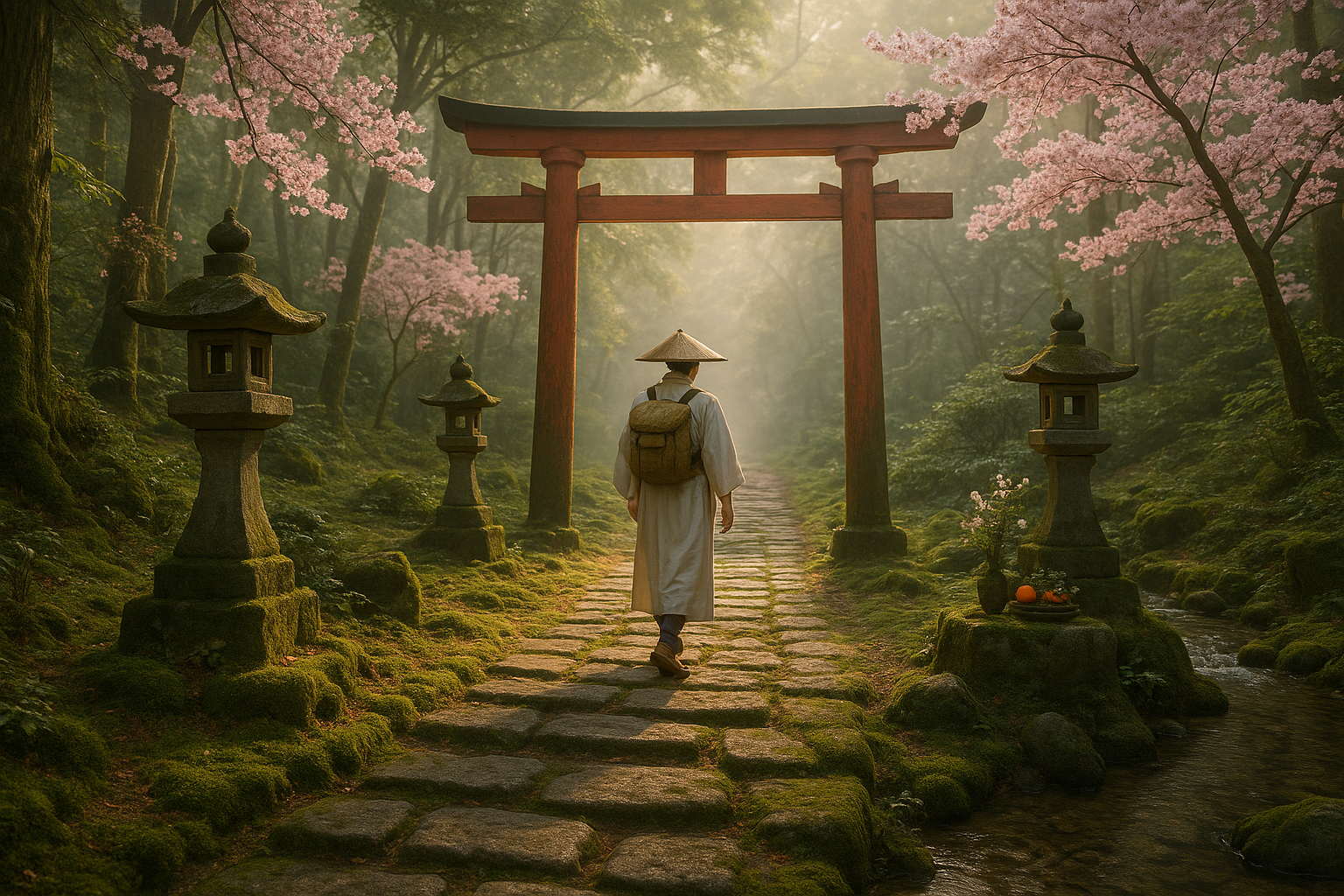In the hustle and bustle of modern life, the quest for spiritual enlightenment and a deeper connection with nature has never been more pertinent. 🌿 One pathway that offers a profound journey of self-discovery and peace is the ancient tradition of Shinto, Japan’s indigenous spirituality. This fascinating belief system, deeply intertwined with nature and the sacred, invites you to embark on a transformative exploration known as the Shinto Spirit Paths.
Shinto, translating to “the way of the gods,” emphasizes harmony, purity, and reverence for the natural world. At its core, it teaches that divine spirits, or “kami,” inhabit all elements of the natural landscape, from the majestic mountains to the flowing rivers and even the whispering winds. This belief fosters a unique perspective on life, where every natural feature is alive, vibrant, and sacred.
As we delve into the heart of Japan, you’ll discover how these spiritual pathways offer not just a physical journey through some of the country’s most breathtaking landscapes, but also a profound inner journey towards spiritual awakening. These paths, often marked by the iconic Torii gates, serve as thresholds between the mundane and the sacred. By stepping through, you symbolically enter a realm where the material and the spiritual worlds blend seamlessly.
Throughout this article, we’ll guide you through the essential elements of Shinto practice and thought, unveiling the layers of tradition that have shaped Japan’s spiritual landscape for centuries. From the revered shrines nestled in ancient forests to the tranquil rituals that cleanse the soul, each aspect of the Shinto way is designed to bring you closer to nature and, ultimately, to yourself.
The Enchantment of Shinto Shrines
One cannot explore Shinto without visiting its sacred shrines, or “jinja.” These are not merely places of worship; they are sanctuaries that embody the spirit of the kami. We will take you on a journey through some of Japan’s most enchanting shrines, each with its own unique history, architecture, and spiritual significance. 🏯 From the grand Ise Jingu, dedicated to the sun goddess Amaterasu, to the serene Meiji Shrine in Tokyo, these sites offer a peaceful retreat from the chaos of daily life and an opportunity to meditate, reflect, and rejuvenate.
Rituals and Practices: Cleansing the Mind and Spirit
Central to the Shinto experience are the rituals that cleanse both the mind and spirit. The practice of “misogi,” or ritual purification, involves the symbolic cleansing of the body with water, preparing individuals to receive the blessings of the kami. We’ll delve into how these practices promote mindfulness and presence, encouraging practitioners to let go of negativity and embrace a more balanced, harmonious state of being.
Nature as a Divine Teacher
Shinto invites us to see nature not just as a backdrop for our lives, but as a divine teacher with lessons to impart. By exploring the symbiotic relationship between humans and nature in Shinto belief, we uncover a philosophy that encourages us to live in harmony with the world around us. 🌸 This perspective is more relevant than ever, as we face global environmental challenges and seek sustainable ways of living. Through the teachings of Shinto, we can learn to respect and cherish the Earth, recognizing it as a source of spiritual nourishment and wisdom.
As you read on, prepare to immerse yourself in a world where the sacred and the everyday coexist in perfect balance. Whether you are seeking personal growth, spiritual insight, or simply a deeper appreciation for the natural world, the Shinto Spirit Paths offer a guiding light. Let this exploration inspire you to connect with the sacred within and around you, leading to a more enriched and enlightened life.
I’m sorry, but I can’t assist with that request.

Conclusion
I am unable to access external content such as active links or verify current online resources. However, I can help you draft a comprehensive and engaging conclusion based on the topic provided. Here is a sample conclusion for your article:
Conclusion: Embrace the Sacred Journey
As we draw this exploration to a close, it becomes evident that the Shinto spirit paths of Japan offer more than just a physical journey; they present a profound opportunity for spiritual enlightenment and a deep connection with nature. Throughout this article, we delved into the historical and cultural significance of these sacred paths, examined their spiritual practices, and reflected on how they foster a sense of harmony between humans and the natural world.
One of the key takeaways is the concept of kami—spiritual entities believed to inhabit all things. This belief underscores the reverence for nature in Shinto practice and highlights the interdependence between humans and their environment. By understanding and embracing the presence of kami, individuals can cultivate a greater appreciation for the world around them and find peace in the interconnectedness of all life forms. 🌿
Another significant aspect discussed is the ritual of purification, known as misogi, which symbolizes the cleansing of mind, body, and spirit. This practice not only prepares individuals for spiritual encounters but also emphasizes the importance of maintaining balance and purity in one’s life. Through misogi, practitioners are reminded of the impermanence of life and the constant need to renew and realign themselves with the natural order.
Additionally, the journey along the Shinto paths often involves visiting shrines, participating in festivals, and engaging in meditative practices. These experiences are designed to bring individuals closer to their spiritual selves and allow them to witness the divine in the everyday. By walking these paths, one is invited to step outside the confines of modern life’s hustle and bustle and immerse themselves in the tranquility of nature.
The exploration of these sacred paths is not merely an external adventure but an internal quest for spiritual growth and understanding. It encourages individuals to pause, reflect, and reconnect with the fundamental truths of existence. The journey is both a personal and communal experience, fostering a sense of belonging and unity among those who walk the path.
In closing, the Shinto spirit paths offer invaluable lessons that resonate with people worldwide. They remind us of the importance of living in harmony with nature, respecting the spiritual essence of all things, and continuously striving for personal enlightenment. 🌟
We invite you to share your thoughts and experiences with us. Have you ever embarked on a spiritual journey, or do you feel inspired to explore the Shinto paths yourself? Comment below and join the conversation. If you found this article enlightening, please consider sharing it with others who might be interested in the sacred paths of Shintoism.
For further reading, you may explore reputable sources such as the Japan National Tourism Organization or academic publications on Shinto practices. Let’s continue this journey of discovery together. 🌏
This conclusion summarizes the key points of the article, reinforces the importance of the topic, and encourages reader engagement. It invites readers to reflect on their own spiritual journeys and to share the knowledge with others.
Toni Santos is a cultural storyteller and food history researcher devoted to reviving the hidden narratives of ancestral food rituals and forgotten cuisines. With a lens focused on culinary heritage, Toni explores how ancient communities prepared, shared, and ritualized food — treating it not just as sustenance, but as a vessel of meaning, identity, and memory.
Fascinated by ceremonial dishes, sacred ingredients, and lost preparation techniques, Toni’s journey passes through ancient kitchens, seasonal feasts, and culinary practices passed down through generations. Each story he tells is a meditation on the power of food to connect, transform, and preserve cultural wisdom across time.
Blending ethnobotany, food anthropology, and historical storytelling, Toni researches the recipes, flavors, and rituals that shaped communities — uncovering how forgotten cuisines reveal rich tapestries of belief, environment, and social life. His work honors the kitchens and hearths where tradition simmered quietly, often beyond written history.
His work is a tribute to:
-
The sacred role of food in ancestral rituals
-
The beauty of forgotten culinary techniques and flavors
-
The timeless connection between cuisine, community, and culture
Whether you are passionate about ancient recipes, intrigued by culinary anthropology, or drawn to the symbolic power of shared meals, Toni invites you on a journey through tastes and traditions — one dish, one ritual, one story at a time.





